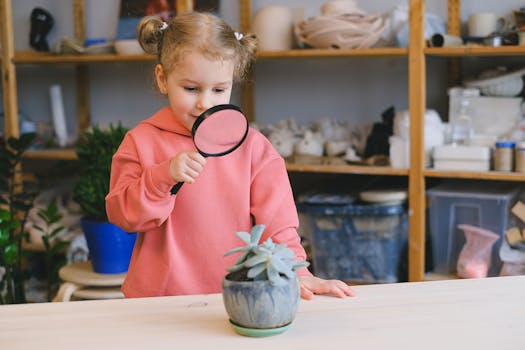As an affiliate, I earn from qualifying purchases, but this doesn't affect the reviews or recommendations—your trust is important to me!
Creating Your Own Rainbow Lava Lamp Science Experiment at Home

Today, We're Making:
- DIY Rainbow Lava Lamp Experiment
- Future City Blueprint: Create a project where kids have to design a futuristic city with all the necessary facilities based on the tools and knowledge in 2025. They will use graph paper for mapping the city layout, markers for landmarks, and recyclable materials for building models. They will gain knowledge about urban planning, recycling, and learn about advancements in technology and infrastructure by 2025.
- Plant Growth Experiment: Set up a project to grow different plants in the same conditions and identify which grow faster. This will help kids understand photosynthesis.
When was the last time you were truly fascinated by a rainbow?
Those magnificent arcs of colour that have a way of stirring up a sense of wonderment in all of us. Now, imagine if you could capture that entrancing spectacle in a bottle.
Well, with our DIY Rainbow Lava Lamp Experiment, you can do just that!
A fun science undertaking that blends the magic of metamorphic liquids with the vibrancy of a rainbow. Not just an engaging diversion, but a hands-on science activity that makes learning a real treat for adults and kids alike.
Get ready to add some serious color to your home science projects with this easy, beginner-level, lava lamp-inspired science experiment.
Ingredients Needed for Your DIY Rainbow Lava Lamp Experiment
Firstly, let's cover what you'll need for this fun adventure in home science projects. Thankfully, most of these items may already exist in your everyday household.
- A clear glass container
- Vegetable oil
- Food coloring (Rainbow colors)
- Effervescent tablets (like Alka-Seltzer)
These are the main elements that will set the stage for your very own Rainbow Lava Lamp experiment. The clear glass container is a canvas for our mesmerizing, colorful spectacle, while the vegetable oil, food coloring, and effervescent tablets help create the magic in action!
Creating a Rainbow Fountain
Starting off might seem like a delicate task, but rest assured, this is one of the many easy science experiments that you can conduct without hassles. Here's how to make a lava lamp that's full of color and life.
- Fill up 3/4 of the glass container with vegetable oil.
- Pour water into the same container until it reaches almost full.
- Add a few drops of each food coloring to the container to create a rainbow effect. Red, orange, yellow, green, blue, indigo, or violet - the shades are up to your taste.
- Break up an effervescent tablet and drop it into the container.
As you add the tablet, you'll notice that the reaction between the tablet and water creates gas bubbles. These bubbles rise through the oil creating a captivating display that mimics the motion in a lava lamp. It's a sight to behold, I assure you!
Why This Rainbow Lava Lamp Experiment is a Win
There are plenty of kids science experiments out there. But how many of them are as stunning as a DIY Lava Lamp project? Not only does this rainbow science experiment provide a blast of bright and cheerful colors, but it is also an exceptional opportunity to teach children about the concept of density and the behavior of oil and water.
Whether you are a parent looking to inject some fun science into the lives of your children, a teacher looking for interactive science experiments, or you are just a big kid at heart looking forward to DIY kids experiments, this homemade lava lamp offers a chance for everyone to learn, explore and marvel within the comfort of home. Grab this opportunity and unlock the entrancing magic of the rainbow at home!

In Essence, The Rainbow Lava Lamp DIY Project
Is an artistic embrace of science that gets to frolic under the vibrant shades of a rainbow. With just household items and a dash of your curiosity, you get to kindle a learn-filled spectacle right in your living room.
So, whether it's the allure of the nostalgic lava lamp calling you or the mystifying science behind it sparking your interest, embark on this simple experiment, enjoy the process, and unleash a dazzling rainbow of knowledge and fun into your life!
It's Time To Say Yes To Science-Rich, Splendidly Colorful Moments
And remember, the wonder of a rainbow never cease.

You May Also Like These:
Future City Blueprint: STEM Project Instructions
Overview: This STEM project requires your child to create a blueprint of a futuristic city with all the necessary facilities. This project will encourage creativity, critical thinking, and spatial awareness as they envision the future in 2025. Materials Required:- Graph paper (minimum size A3)
- Pencil
- Eraser
- Ruler
- Colored pencils or markers
- Reference books or internet for researching future technologies
Instructions:
Step 1: Research and IdeasBefore starting the sketching process, encourage your child to research current and predicted future technologies. This could be related to transportation, building structures, energy production, and community facilities.
Step 2: Planning the CityNext, initiate a brainstorming session about what features they would like to integrate into their futuristic city. To ensure the city is functional, it should include at least the following areas: residential, commercial, industrial, and green spaces. They also need to consider public transportation, utilities, and recreational spaces.
Step 3: Sketching the LayoutHand your child the graph paper and let them start mapping the city layout. This is the step where they figure out where they want to place all their structures and facilities. Encourage them to draw in pencil first, so they can easily make changes.
Step 4: Add Details and LabelsOnce they are satisfied with the primary layout, they can begin to add details to each area. They can use colored pencils or markers to differentiate between various sections. Don't forget to label all the structures and facilities.
Step 5: Review and RedesignEncourage your child to review their design. Can the residents get to work/school/shops/parks easily? Are there enough green spaces? Is there a good transportation network? If there are areas of improvement, allow your child to make changes to their design.
Step 6: PresentationOnce your child is satisfied with their futuristic city plan, let them present it to family members. They can describe their city, the different sectors, and which future technologies they've incorporated.
This project allows your child to not only learn about urban planning but also gives them an opportunity to explore future technologies and sustainable development concepts. Most importantly, though, they'll be having fun while learning, which is a hallmark of successful STEM practice.
STEM Urban Planning Project with Recyclable Materials
Materials needed:- Cardboard
- Old magazines/Newspapers
- Scissors
- Glue
- Paints and brushes
- Marking pens
Step-by-Step Instructions:
Step 1: Preparation
Gather all your materials in one place. Set the newspapers or magazines to avoid any mess.
Step 2: Sketching the City Plan
Using your marking pen, sketch the layout of the city on the cardboard. You can include roads, buildings, parks, etc. Use old photos or images from the internet as references.
Step 3: Cutting and Pasting
Cut out shapes from the cardboard and Newspapers or Magazines for the buildings, trees, cars, and other objects. Glue them on the appropriate places on the city layout.
Step 4: Painting
Now it's time to bring life to the city. Paint the buildings, parks, roads, and other features using your paints and brushes.
Step 5: Adding Finishing Touches
Use your marking pens to add details to the buildings, roads, etc. Let your imagination run wild!
Note: Adult supervision is necessary, while using scissors.
STEM Project: Urban Planning Using Recyclable Materials
Objective: To gain a deeper understanding of urban planning and the importance of recycling by building a model city using recyclable materials
Materials Needed:
- Cardboard boxes of varying sizes
- Plastic bottles and lids
- Egg cartons
- Aluminium cans
- Coloured markers or paint
- Glue or double-sided tape
Instructions:
1. Plan Your City:Before construction begins, spend some time sketching out a layout for your city. Think about the various elements that make up an urban area - housing, businesses, parks, factories, roads, and civic buildings.
2. Prepare Your Materials:Begin by thoroughly washing all recyclable materials. Anything that can't be cleaned properly should be disposed of properly.
3. Begin Construction:Use your design plan as a guide and start building! Think about how the buildings in a city need to coexist. How does one area fit with another?
4. Decoration:Once the layout is complete, you can begin to decorate. Use paint or colored markers to bring your city to life.
5. Reflection:Take a moment to reflect on the work you've done. What did you learn about urban planning? What would you do differently next time?
STEM Projects: DIY Recycling Paper Project
Ingredients
- Old unwanted papers (Non-glossy)
- A large bowl
- Water
- Blender
- Screen frame
- Clean cloth or sponge
- Towels or absorbent cloth.
Instructions
1. Prepare Your Materials
Collect all the listed ingredients.
2. Shred Your Paper
Rip up your paper into small pieces and put them into the large bowl.
3. Soak the Paper
Pour water into the bowl until the paper is covered. Allow to soak for a few hours or overnight.
4. Blend the Paper
Transfer the soaked paper along with some of the water into a blender. Blend until the mixture becomes a slurry.
5. Pour the Mixture onto the Screen
Pour the paper slurry onto the screen. Spread it out evenly with your hands or a flat object.
6. Drying Process
Place a piece of cloth over the slurry on the screen. Pat it gently with a sponge to absorb the excess water, then slowly and carefully remove the screen from under the slurry. Cover the slurry with towels and press gently to absorb more water. Let it dry completely.
7. Enjoy Your Recycled Paper
Once dry, your recycled paper is ready to use! Now you can draw, paint or use it for any other creative activities.
Plant Growth Experiment
Objective: This exciting STEM project will help you and your children understand the process of photosynthesis and plant growth. By growing different plants under the same conditions, you can understand which plants grow faster and why. Materials Needed:- 3 - 5 different types of seeds (beans, peas, sunflowers, etc.)
- Plant pots or plastic cups with holes at the bottom
- Potting soil or garden soil
- A sunny window or a grow lamp
- Water
- Stakes and tape to label each plant (optional)
- Plant diary or notebook for observations
Instructions
- Prepare the Soil: First, fill your plant pots or cups with potting soil up to 1 inch below the rim.
- Sow the Seeds: Next, plant the seeds in the pots following the instructions on the seed packets. If instructions aren't available, a general rule is to plant the seeds twice as deep as they are wide.
- Label the Plants: Using the stakes and tape, label each plant so you can remember which type of seed was sown in each pot.
- Place in Sunlight: Position the plant pots in a sunny window or under a grow lamp. Ensure they receive plenty of light every day, as this is essential for photosynthesis.
- Water Regularly: Provide the plants with water as recommended by the seed packets or keep the soil moist but not soggy.
- Keep a Diary: Have your children observe the growth of the plants every day and write down their observations. They should note down when the first sprouts appear, the rate of growth, the color of the plants, and when flowers or fruit begin to form.
- Analyse Results: At the end of the experiment, compile the observations and analyze which plants grew faster and why. Discuss the reason with your kids and explore how different conditions might affect the results.



























